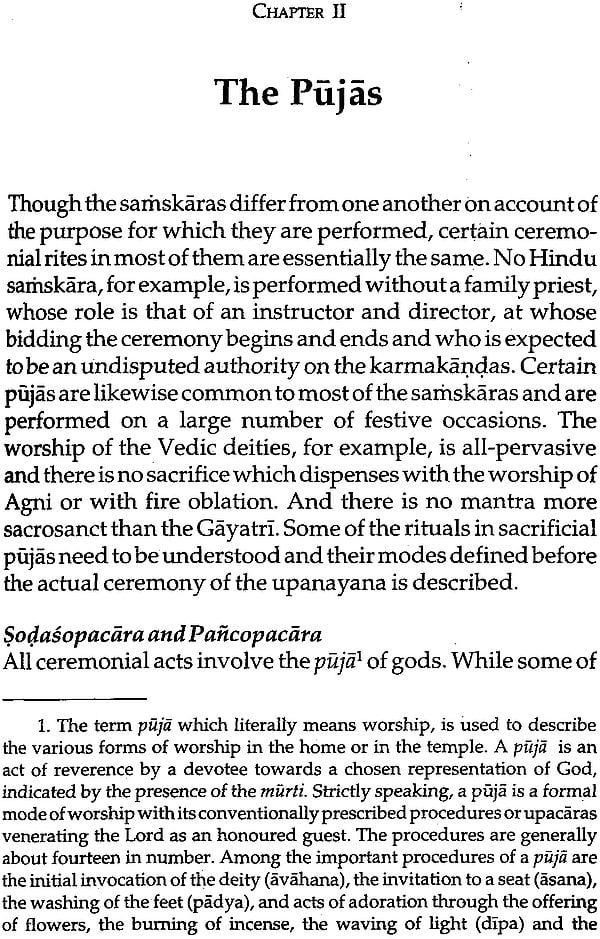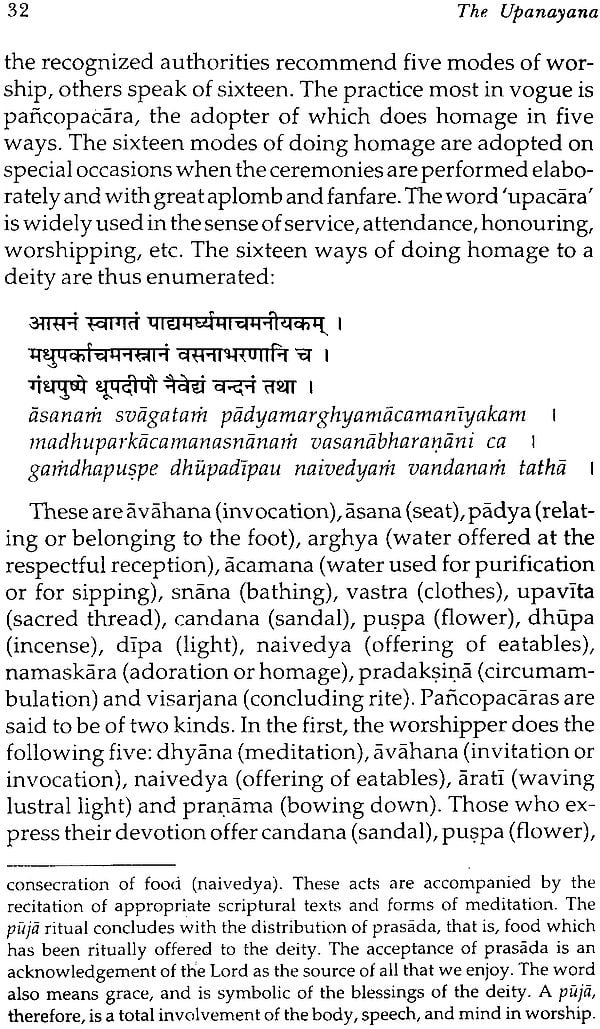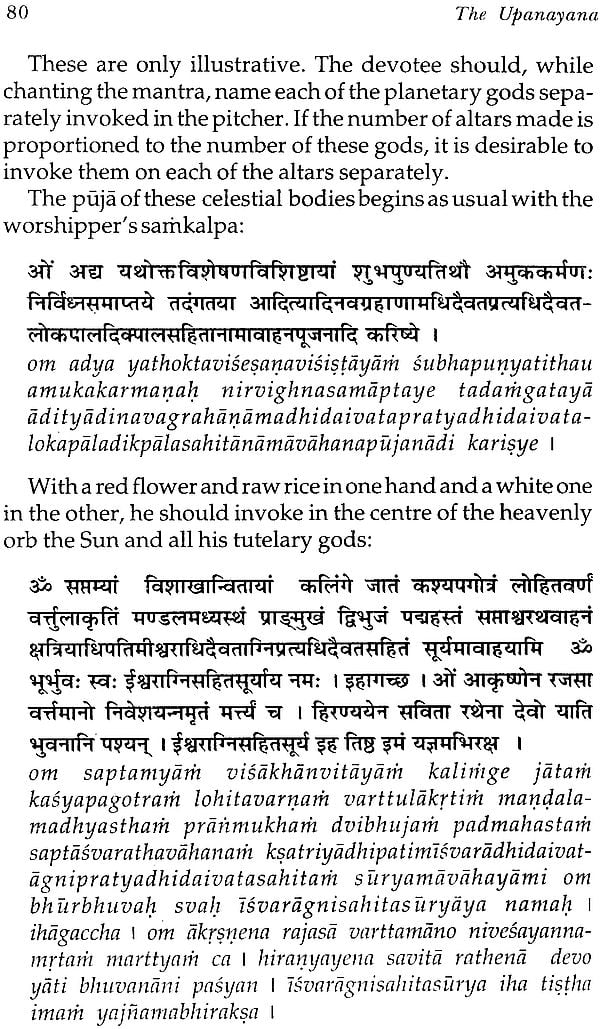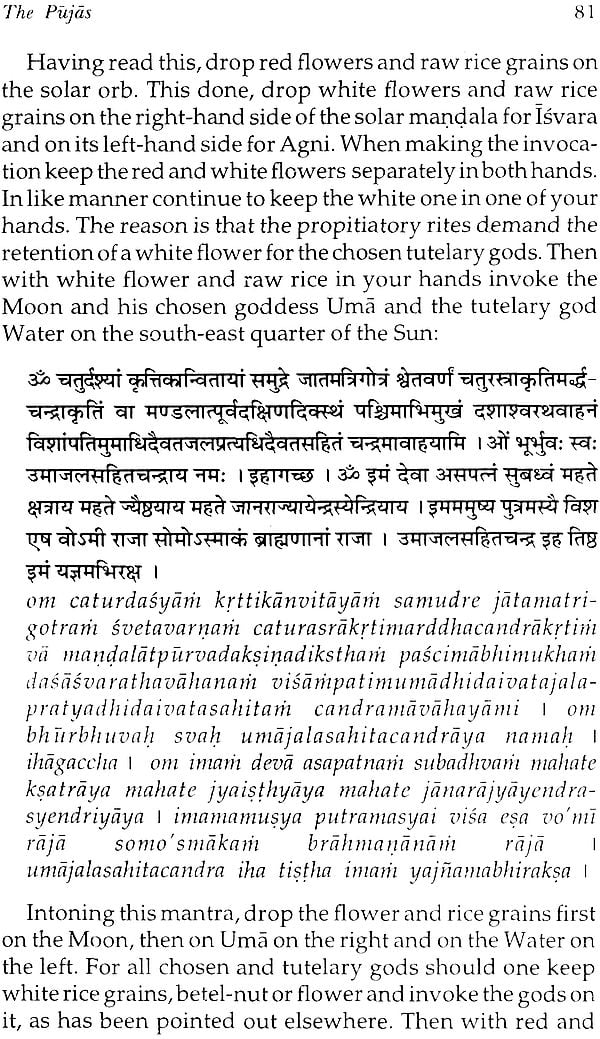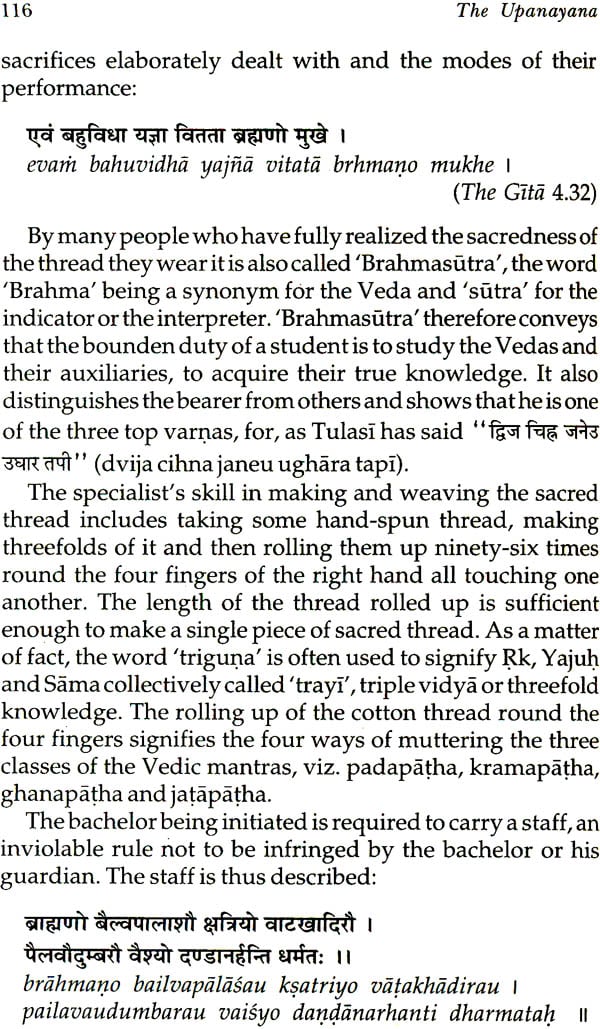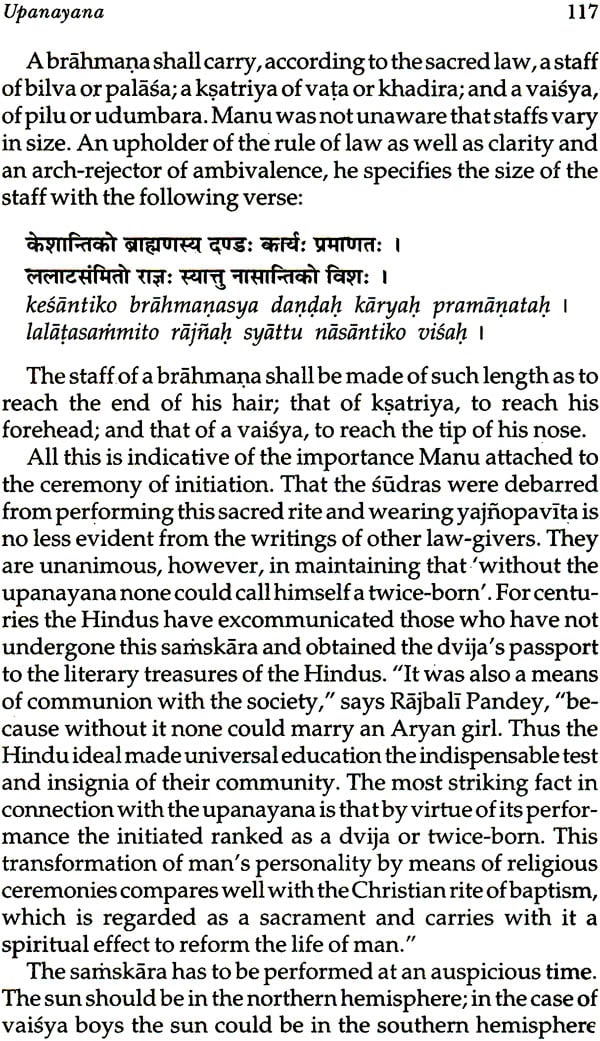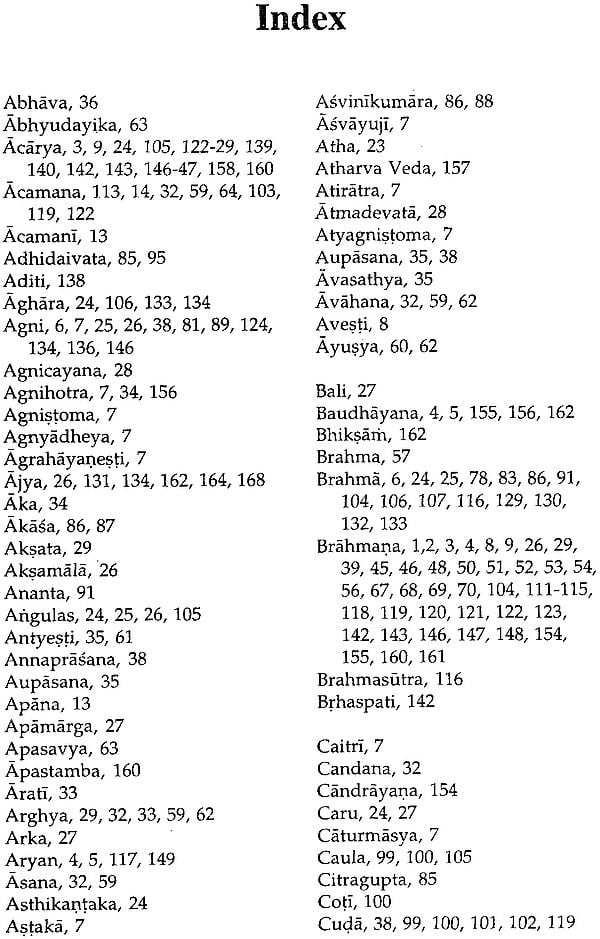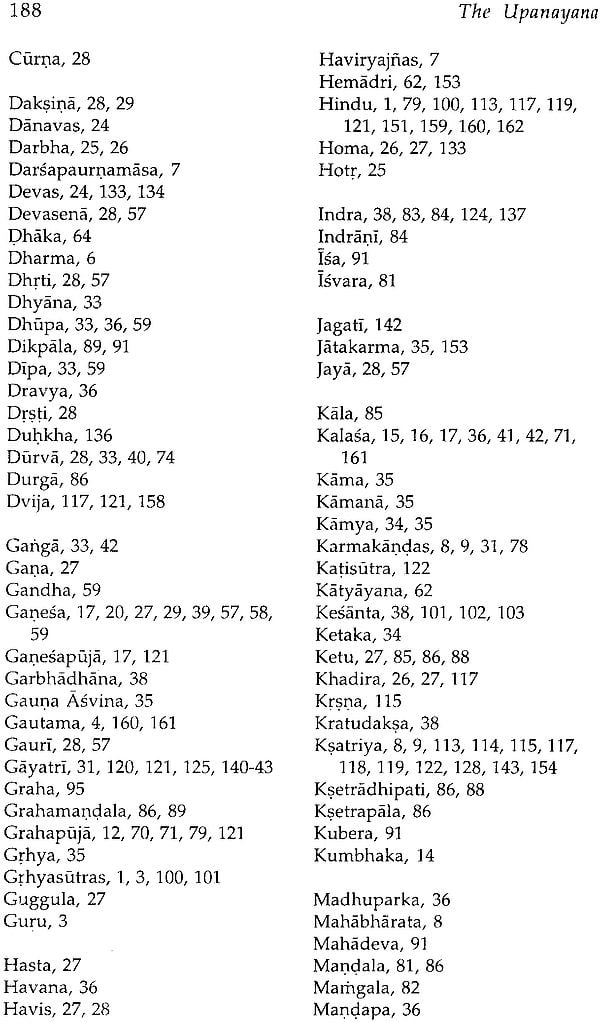
The Upanayana - The Hindu Ceremonies Of The Sacred Thread
Book Specification
| Item Code: | NAB458 |
| Author: | R.C. Prasad |
| Publisher: | MOTILAL BANARSIDASS PUBLISHERS PVT. LTD. |
| Language: | English |
| Edition: | 2014 |
| ISBN: | 9788120812406 |
| Pages: | 202 (B & W Figure: 3) |
| Cover: | Paperback |
| Other Details | 8.5" X 5.5" |
| Weight | 260 gm |
Book Description
From the Jacket:
Upanayana is one of the sixteen samskaras or purificatory rites in which a boy is invested with the sacred thread and thus endowed with second or spiritual birth and qualified to learn the Veda by heart. In this ceremony the boy goes to an Acarya well-versed in the Vedas with a view to be initiated into one of the three twice-born classes. From the day the initiation ceremony takes place, the young celibate commits himself to a life of austerity and abstinence; he chooses to lead a life of austerity and abstinence; he chooses to lead a life rigorously disciplined by vows and disciplinary rules. This is an important samskara in the life of an orthodox Hindu. The book describes the ceremony, the Puja, the mantras to be recited and other relevant details in a scholarly treatment of the subject.
About the Author:
Dr. R.C. Prasad, taught English Literature at Patna University for over forty years, during which he wrote scores of books, including biographies and translations, the most outstanding of which is his prose rendering of the Ramacaritamanasa.
Preface
In days gone by every Hindu was socially and religiously required to have a family priest, a brahmana, who was revered and admired for his scholarship, especially for his vast knowledge of the Vedas and the Hindu samskaras. He functioned as a family preceptor and spiritual guide, not as a casual brahmana visitor whose services are solicited only on certain festive occasions by the needy when no other priest is available. The work of such roving vendors of ceremonial decrees is more business-oriented than in keeping with the sacred laws. It is surely difficult today to come across a guru who models his living on that of the rsis dedicated to the performance of self-purifying penance and sacrifice. The seers in days of yore were mostly enlightened men who had realized during their studentship that were they to guide the laity and be called 'Acaryas' or 'Panditas' the sobriquets which are often attached to their names, they must renounce all sensual pleasures. Manu, their great lawgiver, had ordained with his inimitable clarity that
prapanat sarvakamanam parityago visisyate ||
"If one man," Manu declares, "should obtain all those sensual enjoyments and another should renounce them all, the renunciation of all pleasure is far better than the attainment of them." A student was expected to practice renunciation, detachment, and self-restraint. Here again Manu's instruction was respectfully acquiesced in and the forest celibates remembered both in theory and in practice that
visayesu prajustani yatha jnanena nityasah ||
"Those organs which are strongly attached to sensual pleasures, cannot so effectually be restrained by abstinence from enjoyments as by a constant pursuit of true knowledge."
It appears from Manu's institutes that they are meant as much for the householder in the second order of life-garhasthya-as for the student. The laws for the brahmanas are severer and they are expected to subject themselves to harder physical and mental disciplines, forsaking all attachment of their organs to sensual pleasures. A brahmana student must keep them under complete control and bear in mind that desire is never extinguished by the enjoyment of desired objects; it only grows stronger like a fire fed with clarified butter.
havisa krsnavartmeva bhuya evabhivardhate ||
Even those people who did not belong to the trivargas conceded with reluctant admiration that the majority of the purohitas were adepts at their priestly duties and had acquired considerable merit by subduing their organs. They were taught by their enlightened teachers during their gurukula days that one gains all one's aims if one keeps all the ten organs as well as the mind in subjection. The teacher along with his students stood during the morning twilight muttering the Savitri until the sun appeared; he recited it, seated, in the evening until the constellations were seen distinctly. They all knew how meritorious it was to stand during the early morning hours muttering the sacred mantras, how they removed the guilt contracted during previous night and how those who recited them seated in the evening were able to destroy the sin committed during the day.
But all this appears to have vanished. It is unfortunate that many brahmanas, starkly ignorant of the Vedic rcas and scriptural teachings, are often called upon to perform the ceremonies. There is substance in their contention that since the times have changed, the ceremonial laws too must be thoroughly revised and modified to bring them in conformity with the present-day ethos. They also argue that, as the mantras are in Sanskrit, very few people are able to chant them with complete understanding of their inherent meaning and importance. Their bewilderment is understandably genuine in the face of the difficulties involved in following the instructions given by the institutors. It is to meet their demand for a simple text with explanatory instructions that this book has been written. Its readers can be scholarly priests or non-scholarly householders or both. To some this may sound a profanation of the ceremonial laws, but the intention is pious and therefore this attempt to democratize and expound the esoteric is forgivable.
I am considerably indebted to Mr. Digvijay Narayan Singh of the Department of English, Patna University, who came to my rescue when my eyesight was failing due to a sudden eye haemorrhage. With exemplary patience and devotion, he worked day and night preparing the rough and final drafts of the manuscript, checking the typescript and giving it the last Midas touch.
The Law Books, no less than the Crhyasutras, provide ample materials on the sixteen samskaras or ceremonial rites per- formed in Hindu homes under the guidance of a family priest. Sometimes the manner of performing the ceremonies is given at length, while at other times the details are scanty. There is, however, unanimity among the law-givers and institutors of the rules with regard to the qualifications of the priest. He should be a brahmana, they maintain, to whom the most resplendent Lord assigned teaching and studying the Veda, sacrificing for his own benefit and for others, giving and accepting of alms. In one of his well-known verses Manu says:
bhutanam praninah sresthah praninam buddhijivinah |
buddhimatsu narah srestha naresu brahmanah smrtah ||
But all brahmanas are not suited for the job of family priest. Manu rejects even those brahmanas who are learned in the Vedas. Of the learned, only those should be preferred who recognize the necessity and the manner of performing the prescribed duties. Of those who possess this knowledge, those should be preferred who perform them, and of the performers, those who know the Brahman. Manu based his preference on his simple conviction expressed in the follow- ingverse:
utpattireva viprasya murtirdharmasva sasvati |
sa hi dharmarthamutpanno brahmabhuyaya kalpate ||
"The very birth of a brahmana," he maintains, "is an eternal incarnation of the sacred law; for he is born to fulfil the sacred law, and becomes one with Brahman."
The test laid down for the choice of the officiating priest- the purohita-is rigorous. He must be learned in the Vedas; he must recognize both the necessity and the manner of following the prescribed rules or performing the prescribed duties; he must not only possess this knowledge but also know the Brahman. He comes into existence for the protec- tion of the treasury of the law and eats but his own food, wears but his own apparel, bestows but his own in alms; other mortals, adds Manu, subsist through the benevolence of the brahmana. The latter was expected to carefully study the institutes of the sacred law and to duly instruct his pupils in them, 'but nobody else shall do it'. This was deemed imperative because it was held that a brahmana, who studied the institutes and faithfull y fulfilled the duties prescribed in them, was never tainted by sins, arising from thoughts, words, or deeds.
The brahmana's services were sought to conduct the ceremonies and guide the householder for the assurance contained in Manu's Institutes:
punati panktimm vamsyamsca sapta sapta paravaran |
prthivimapi caivemam krtsnameko' piso' rhati ||
The very presence of the brahmana as instructor and guide sanctifies any company with which he may enter, seven ancestors and seven descendents, and he alone deserves to possess this whole earth. The brahmana priest learned in the Vedas studied the smrtis (and the Grhyasutras) because they were (and still are) the best means of securing welfare; they increased understanding, procured fame and long life, and led to supreme bliss.
Among the qualifications of an eligible family priest is not only great learning but also a knowledge of the rule of conduct and of the sacred law. The rule of conduct has been described by Manu as transcendental law-
acarah paramo dharmah srutyuktah smarta eva ca |
tasmadasmin sada yukto nityam syadatmavan dvijha ||
-whether it be taught in the revealed texts or in the sacred tradition (srutyuktah smarta evaca). All the four castes were therefore expected to follow the immemorial rule of conduct and a brahmana, who transgressed this rule, was cautioned that he would not reap the fruit of the Vedas. Manu added that he who duly followed it could obtain the full reward. "The sages who saw that the sacred law is thus grounded on the rule of conduct, have taken good conduct to be the excellent root of all austerity."
What is lamentable is the dearth of efficient and learned purohitas who are also masters of the rules of the sacraments, the ordinances of studentship, and the most excellent rules of bathing and offering oblations. Instead of eating their own food and wearing their own apparel, they act solely from a desire for rewards, though they know that such a desire must not be nursed. According to Manu, "The desire for rewards, indeed, has its root in the conception that an act can yield them, and in consequence of that conception sacrifices are performed; vows and the laws prescribing restraints are all stated to be kept through the idea that they will bear fruit." The officiating priest, acarya or guru used to be a snataka whose duties were as hard as those of a celibate. One of his duties was to avoid cutting, breaking, scratching and crush- ing anything. According to Gautama, he was expected to be a stay-at-home, nor was he to go to perform a sacrifice without being chosen to officiate as priest. He could go to see it only at his pleasure. Some of the most unavoidable rules of conduct, according to Gautama, were:
He shall always speak the truth.
He shall conduct himself as becomes an Aryan.
He shall instruct virtuous men only.
He shall follow the rules of purification taught in the sastras.
He shall take pleasure in the study of the Vedas.
He shall never hurt any being, he shall be gentle, yet firm, ever restrain his senses, and be liberal.
A snataka who conducts himself in this manner will liberate his parents, his ancestors, and decendents from evil, and never fall from Brahman's heaven.
The rules of internal and external purification were no less rigorous. N a ceremony can be performed unless the host and the priest have duly performed the rite of purification for which the rules were clearly defined. According to Baudhayana, the sacrificial thread has to be made of kusa grass, or cotton, and consist of thrice three strings. It shall hang down to the navel. In putting it on one is expected to raise the right arm, lower the left, and lower the head. The contrary is done at sacrifices to the manes. If the thread is suspended round the neck, it is called nivita: if it is sus- pended below the navel, it is called adhopavita, Both the priestly brahmana and his host were expected to perform the rite of purification, facing the east or the north, and seated in a pure place. They had to place their right arms between their knees and wash both hands up to the wrist and both feet up to the ankles. None was advised to use for sipping the remainder of the water with which he had washed his feet. But if one used that for sipping, he was allowed to do so after pouring a portion of it on the ground. Here again the rules enjoined that he should sip out of the tirtha sacred to Brahman. The part of the hand at the root of the thumb is called the tirtha sacred to Brahman and that above the thumb is called the tirtha sacred to the manes, the part at the tips of the fingers that sacred to the Gods, the part at the root of the fingers that sacred to the rsis, Going still further, Baudhayana ordains not to use for sipping water tha t has trickled from the fingers, nor tha t covered with bubble or foam nor water that is hot, alkaline, or salty, or muddy, or discoloured, or that which has a bad smell or taste. Foreseeing that future genera- tions may be lax in the performance of some of these ceremo- nialduties, Baudhayana ruled that water must not be sipped laughing, nor talking, nor standing, nor looking about, nor bending one's head or one's body forward, nor while the lock on one's crown is united, nor while one's throat is wrapped up, nor while one's head is covered, nor when one is in a hurry, nor without wearing the sacrificial thread, nor stretch- ing one's feet out, nor while one's loins are girt with a cloth, nor without holding one's right arm between one's knees, nor making a sound.
| PREFACE | ix |
| CHAPTER I: INTRODUCTION | 1 |
| CHAPTER II: THE PUJAS | 31 |
| CHAPTER III: THE TONSURE | 99 |
| CHAPTER IV: UPANAYANA | 113 |
| CONCLUSION | 157 |
| APPENDICES | |
| APPENDIX I | 165 |
| APPENDIX II | 171 |
| APPENDIX III | 175 |
| SANSKRIT GLOSSARY | 181 |
| INDEX | 187 |
